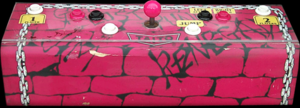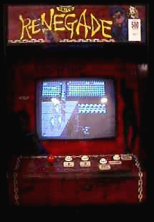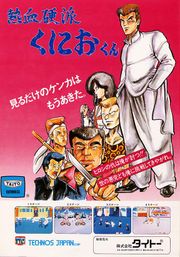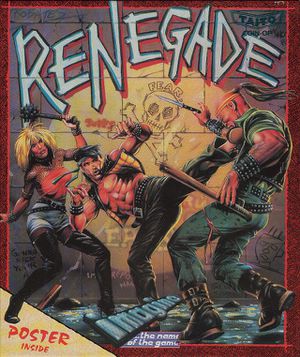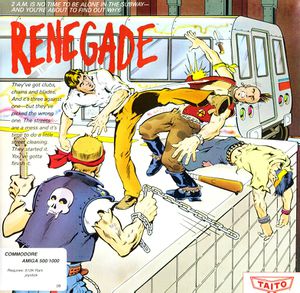Lost In Translation/Renegade
| Renegade | |
|---|---|
| Manufacturer | Technos (Taito America license) |
| Released | 1986 |
| Control Method |
8-way Joystick 3 Button(s) |
| Main CPU | M6502 (@ 1.500 MHz) M6809 (@ 1.500 MHz) |
| Sound CPU | Mono YM3526 (@ 3.000 MHz) Custom (@ 8.000 kHz) |
| Video Details |
Raster (Horizontal) 240 x 240 pixels 60.00 Hz 256 Palette colours |
| Screens | 1 |
| ROM Info | 26 ROMs 851,968 bytes (832.00 KiB) |
| MAME ID | renegade · kuniokub · kuniokun |
About The Game
Renegade is an arcade video game beat-em-up that sees a single player taking on huge gangs of street fighters. The game is spread across four stages levels, each of which is only 2 or 3 screens wide; giving the player nowhere to hide. Renegade was a rather more brutal game than others of its genre, and even allowed the player to keep attacking a downed enemy. It was also possible to pick up fallen enemies and throw them at oncoming fighters.
Renegade's designer would take what they learned while designing and writing Renegade and improve upon it in every conceivable way for the legendary "Double Dragon", released a year later.
Trivia
Apollon Music released a limited-edition soundtrack album (Cassette format) for this game (Nekketsu Kouha Kunio-kun Sound Story) on 05/1987.
Updates
Western version of "Nekketsu Kouha Kunio-kun". The game's graphics were redrawn for the game's localization as Renegade to the game's characters and settings a western feel. The plot was also changed from beating up numerous gangs who are bullying the main character's best friend to rescuing the main character's girlfriend. Kunio, the main character in the Japanese, would return in numerous games including "Nekketsu Koukou Dodgeball-bu", the Japanese version of "Super Dodge Ball", some which underwent a similar localization process when they were released in the west (such as the NES game River City Ransom).
Tips and tricks
On the first 2 levels, try to throw the enemies from the platforms; being careful, of course, to avoid falling from the platform yourself. Also, to kill the third boss, run away from her and hit the kick button (repeat). When fighting the knife gang on the final stage, if you are stabbed even once, you will die. The safest way to defeat them is with dashing punches. Never engage a single enemy or stay one place for too long, otherwise you will be attacked.
Series
- Renegade (1986)
- Target Renegade (1988, Sinclair ZX Spectrum, Commodore C64 & NES)
- Renegade III - The final chapter (1989, Sinclair ZX Spectrum & Commodore C64)
Cabinet and Artwork
Ports
- Consoles
- Nintendo Famicom (1987)
- Sega Master System
- Sony Playstation 2 (2006, "Oretachi Game Center - Nekketsu Kouka Kunio-Kun")
- Computers
- Commodore C64 (1987)
- Amstrad CPC (1987)
- Sinclair ZX Spectrum (1987)
- Thomson TO8 (1988)
- Commodore Amiga (1989)
- Atari ST (1989)
- Apple II
- Thomson M05
Soundtrack Releases
| Album Name | Catalogue No. | Released | Publisher | Comments |
|---|---|---|---|---|
| Kunio-Kun Sound Collection | C228-5008[1] | 1989-06-05 | Apollon Music Industrial Corp | CD version. |
| Nekketsu Kouha Kunio Kun Music Collection | GNCA-7122[2] | 2008-11-21 | Geneon Entertainment | 4 CD version. |
| Nekketsu Kouha Kunio-kun Sound Story | KHY-1013[3] | 1987-03-05 | Apollon | Cassette version. |
| Oretachi Game Center: Nekketsu Kouha Kunio-Kun | N/A[4] | 2006-01-26 | Hamster | CD version. |
External Links
- Sinclair ZX Spectrum version of Renegade at the World of Spectrum




